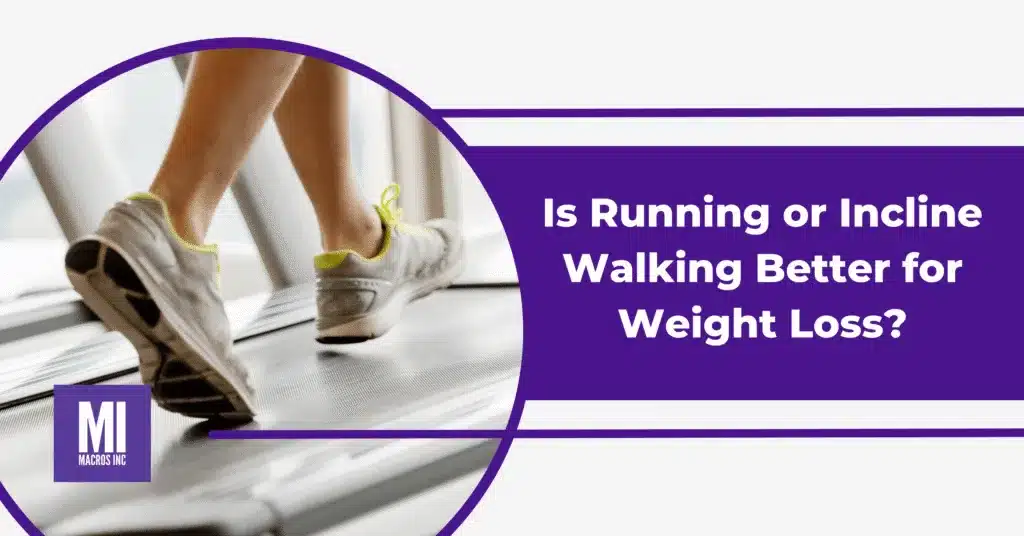When it comes to foot-based approaches to exercise, running and incline walking are about as basic as it gets. Both are tried and true adjuvants to most weight loss approaches and generally require only basic levels of fitness to participate in. Each also needs little equipment, with both the treadmill and the outdoors working well.
However, there is inevitably a debate about which approach is superior for weight loss. The general consensus I see online is that running is the clear winner by burning more calories. While there is a kernel of truth to that, I don’t think it’s quite that simple.
I want to preface this article by saying that this is all evaluated in the context of weight loss. There are other significant benefits to different cardio approaches besides the energy expenditure, i.e. cardiovascular fitness. The emphasis here, however, is the potential for burning calories.
Jump to a Topic
Is Running or Incline Walking Better for Weight Loss?
What Determines Calorie Burn?
When we talk about weight loss, it’s a function of your body expending more calories than it is taking in. Your body then must make up the difference from its own calorie bank, i.e. your fat stores. It’s the classic “calories in = calories out” equation.
When we’re referring to calories out, though, what is that energy being used for? Aside from metabolic processes, you need energy for your muscles to contract and move your body. The amount of energy needed for this can be determined by looking at the forces your muscles are pushing against.
Some Quick Physics
Please don’t click off this article at the mention of physics. I promise to minimize the math PTSD and keep things as simple as possible here. For our purposes, we’re more interested in the actual components of this equation than any actual numbers.
There’s only one physics equation that we need to go over here: The power equation. Power is written as the following equation:

Here P = power, F = force, d = distance, and t = time. If you can remember those, we’re done here. You survived. Let’s move on to how this applies to our matter at hand.
The Three Variables
Now that we have our variables at play, let’s adapt them to our workout. Power is going to be representative of calorie burn, while the other three are going to be the variables in our workout that we can manipulate:
- Force represents the exertion required by your muscles to move your body.
- Distance represents the length of your run/walk.
- Time represents the duration of the workout itself.
To increase calorie burn, we must increase one or more of these factors. Fortunately, each of these can be modified quite easily.
You can increase exertion by increasing the incline of the movement. This makes gravity an increasingly stronger force your muscles must push back against. The more force your muscles output, the greater the energy expended.
Increasing distance is straightforward. The farther you travel, the more energy it takes to get from point A to point B. That’s about as simple as it gets and is why it’s such a common variable to track and manipulate.
Finally, you can alter the duration of the run or walk. This sounds like it should be similar to distance, since longer distance runs are presumed to take more time. Indeed, the two variables are often closely related, as they both factor into your speed. However, duration is a separate adjustable factor entirely. The easiest way to picture this is walking/running a set distance with varying duration. It takes more energy to cover the same amount of ground in less time, and vice versa.
All these factors are contributors to the net calorie expenditure of a given walk/run (Table 1). You don’t even necessarily have to crunch any numbers to determine progression and increase your energy output over time. The easiest way to objectively and incrementally increase your calorie burn is to adjust one variable while keeping the other two constant. For example, if you want to keep your workout limited to 30 minutes, you can choose to either increase the incline or cover more distance each successive workout.
Because there are a lot of different combinations available here, you can see that it’s not quite as easy to compare incline walking vs. flat running. How fast of a walk/run are we talking here? How far? How steep an incline?
| Factor | Definition | How to Increase |
| Calorie Burn | Total energy expended by body | Net increase of the other three factors |
| Exertion | Force exerted by body | Increase incline |
| Distance | Distance travelled | Walk/run farther |
| Duration | Length of workout | Walk/run longer |
Other Factors
Now that we have the big variables accounted for, there are a few other things that can also affect your choice between incline walking and flat running.
Energy Efficiency
In terms of physics, it takes the same amount of energy to cover a set distance, regardless of whether it’s walked or ran. You’re moving the same amount of mass across the same distance, thus equaling the same amount of work.
In practice, though, running usually exerts more energy. This is because, at low to mid speeds, running is actually a less energy-efficient set of motions vs. walking. Therefore, someone who jogs a given distance and speed will burn more calories than someone who walks it. This difference isn’t night and day, but it’s significant enough to mention.
Soft Tissues
Another factor to consider is the effect of running vs. walking on things such as joints, ligaments, and tendons. Running tends to be more strenuous on these tissues, so if these are a potential weak point, you may favor walking instead.
Exertion and Recovery
Exertion and perceived exertion can have a big say in what you pick. If one particular approach is more physically and mentally tiring than the other, there’s a natural inclination to want to avoid it more. Simply put, if you hate a certain mode of exercise, you’re less likely to stick with it.
Mental considerations aside, physical recovery is also a very real consideration. This is particularly true with high-intensity workouts, e.g. HIIT. Particularly stressful and intense bouts of running have a much bigger impact on recovery than walking or a light jog. If you’re looking to work out frequently, this can negatively affect your subsequent workouts over the following days.
Conclusion
For weight loss, there really isn’t a clear winner between incline walking and flat running. Hopefully, this article has outlined how many different factors are at play in determining one vs. the other. Above all, the most important deciding factor is what you like to do and what you can stick with. An exercise you can do reliably and dependably will be a much better fit than forcing yourself to do one you dislike for the sake of being “optimal.”
Try our nutrition coaching, for free!
Be the next success story. Over 30,000 have trusted Macros Inc to transform their health.
Simply fill out the form below to start your 14-day risk-free journey. Let's achieve your goals together!

